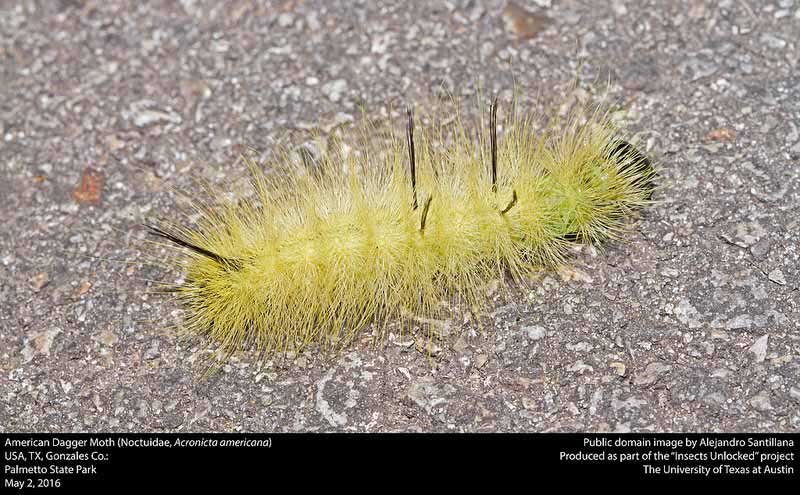
Superregnum: Eukaryota
Regnum: Animalia
Subregnum: Eumetazoa
Cladus: Bilateria
Cladus: Nephrozoa
Cladus: Protostomia
Cladus: Ecdysozoa
Cladus: Panarthropoda
Phylum: Arthropoda
Subphylum: Hexapoda
Classis: Insecta
Cladus: Dicondylia
Subclassis: Pterygota
Cladus: Metapterygota
Infraclassis: Neoptera
Cladus: Eumetabola
Cladus: Endopterygota
Superordo: Panorpida
Cladus: Amphiesmenoptera
Ordo: Lepidoptera
Subordo: Glossata
Cladus: Coelolepida
Cladus: Myoglossata
Cladus: Neolepidoptera
Infraordo: Heteroneura
Cladus: Eulepidoptera
Cladus: Ditrysia
Cladus: Apoditrysia
Cladus: Obtectomera
Cladus: Macroheterocera
Superfamilia: Noctuoidea
Familia: Noctuidae
Subfamilia: Acronictinae
Genus: Acronicta
Species: Acronicta americana
Acronicta americana, the American dagger moth, is a moth of the family Noctuidae. It was originally described by Thaddeus William Harris in 1841 and is native to North America.
Description
The American dagger moth has a wingspan of 50 to 65 mm (2.0 to 2.6 in) It usually has a sharp, double postmedian line, with white in between the two lines.[1] There is a black dash on the anal area of the forewing. The hindwing is gray with a faint, darker gray median line in the male.[1] The female is similar, except the hindwing is completely dark.
Subspecies
Acronicta americana americana
Acronicta americana obscura
Acronicta americana eldora
Distribution
The American dagger moth is found in North America east of the Rocky Mountains.[2]
Flight period
The American dagger moth can be seen from April to September throughout its range.[1] Caterpillars can be seen from July to October. It has one brood in the north and two to three broods in the south.[3]
Habitat
Caterpillar
Caterpillar, head
American Dagger Moth Caterpillar.jpg
The American dagger moth is found in deciduous woodlands and forests.[3]
Life cycle
The young caterpillar is densely covered with yellow setae. The older caterpillar's setae are either pale yellow or white. All instars have thin, black setae on the first and third abdominal segments. On the eighth abdominal segment, there is one tuft of black setae. The caterpillar will reach a length 50 mm (2.0 in).[3] While there are numerous reports of the larval hairs of this species sometimes causing skin irritation in humans, there is no evidence that they possess any form of venom.[4]
Host plants
Acer – maple species
Acer negundo – box elder
Aesculus hippocastanum – horse chestnut
Alnus – alder species
Betula – birch species
Carpinus caroliniana – American hornbeam
Carya – hickory species
Castanea – chestnut species
Cercis – redbud species
Corylus – hazel species
Fraxinus – ash species
Juglans – walnut species
Platanus – sycamore species
Populus – poplar species
Quercus – oak species
Salix – willow species
Tilia – basswood species
Ulmus – elm species
References
Covell Jr, Charles V. (2005) [First published 1984]. Moths of Eastern North America. Martinsville, VA: Virginia Museum of Natural History. p. 82. ISBN 1-884549-21-7.
Bartlett, Troy; et al. (February 16, 2004). "Species Acronicta americana - American Dagger Moth". BugGuide. Retrieved August 12, 2010.
Wagner, David L. (2005). Caterpillars of Eastern North America. Princeton, NJ: Princeton University Press. p. 324. ISBN 0-691-12144-3.
Wagner, David L.; Schweitzer, Dale F.; Sullivan, J. Bolling & Reardon, Richard C. (2011). Owlet Caterpillars of Eastern North America. Princeton University Press. ISBN 978-069115042-0.
Retrieved from "http://en.wikipedia.org/"
All text is available under the terms of the GNU Free Documentation License

